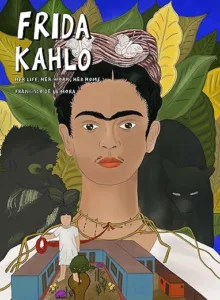Frida Kahlo: Her Life, Work, Her Home
Fransisco de la Mora
SelfMadeHero
Published April 11, 2023
Amazon | Bookshop | Goodreads
About Frida Kahlo: Her Life, Her Work, Her Home
Endorsed by the Frida Kahlo Museum in Mexico City, writer, and illustrator Francisco de la Mora’s full-color graphic novel explores the public and private faces of the iconic artist.
Frida Kahlo, remembered as one of the most inspiring personalities of the 20th century, was a woman of two intertwined: she was both a charismatic and empowered artist exploring themes of resistance, authenticity, cruelty, and suffering and a more private person whose wounded body caused her a lifetime of pain that underpinned the many successes and disappointments that marked her time in the world.
Revealing and exploring these two Fridas, Francisco de la Mora’s graphic biography allows the reader to see just how far ahead of her time this complex artist was in her understanding of gender inequality and the culture of machismo, topics that remain relevant to this day and continue to lend resonance to Kahlo’s painting. Diego Rivera, Kahlo’s husband and fellow artist, described her work as “acid and tender, hard as steel but delicate and fine as a butterfly’s wing.” His words might apply equally to Frida herself.
My Review
One of the reasons I read so many graphic novels is that my niece and nephew love them, so I’m always looking for things they’re interested in. Usually, they lean toward fiction, but they’re both artists, so I thought maybe they might like this one for something different.
I loved the detailed descriptions of events from Frida Kahlo’s life– there was so much that I didn’t know before about her life, her family, and her work. I had no idea she was disabled, and from such a young age. The fact that she created so much while in so much pain is incredible to me. As a migraine sufferer, I can’t imagine what personal cost those efforts must have been for her.
The descriptions of her work and people’s reactions to it made me want to find a gallery showing Frida Kahlo’s paintings and see them in person. That would be really cool.
The only drawback for me reading this book is that some of the drawings of people in the panels are very small, so it’s hard to see their faces. There were moments when I wished the illustrations of faces had been more detailed so that the images were more emotionally evocative. On the whole, I enjoyed the book, though.
Content Notes
Recommended for Ages 10 up.
Representation
Frida is a Latina woman born in Mexico. Her father was German.
Profanity/Crude Language Content
None.
Romance/Sexual Content
References to Frida and her husband Diego having affairs, including her husband’s affair with Frida’s younger sister.
Spiritual Content
None.
Violent Content
Some descriptions of the extensive injuries Frida suffered after she was involved in a bus accident and her chronic health issues afterward.
Drug Content
A few panels show adults drinking alcohol.
Note: This post contains affiliate links, which do not cost you anything to use, but which help support this blog.
